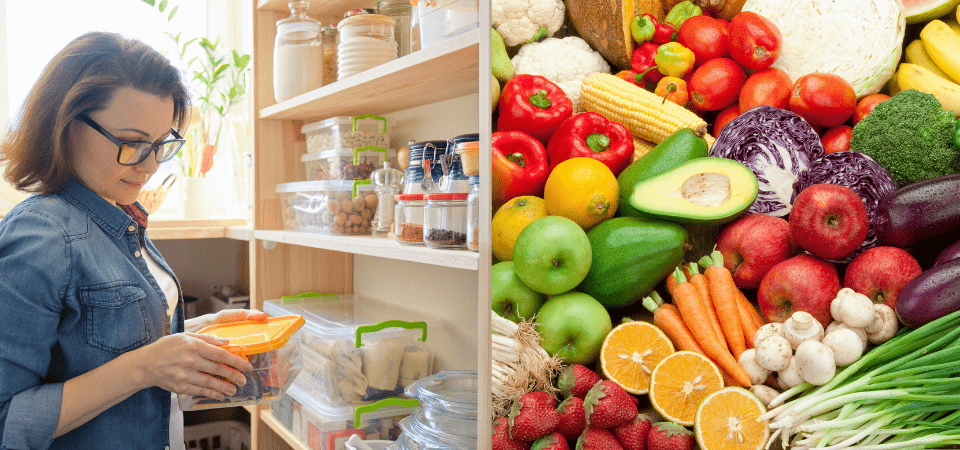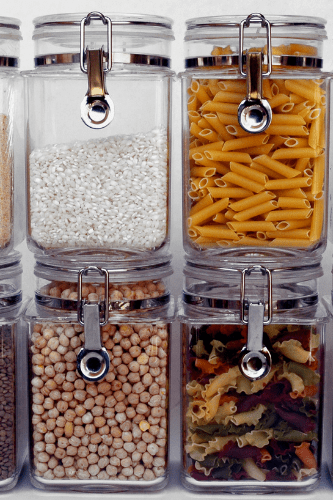
Soft Spots On Apples.
Moldy bread. Stale snacks. Brown bananas. With the snap of a finger, avocados seem to go from firm to rotten, ready-to-eat greens have gone limp, and you’re at a loss for how to best preserve what you can until your next grocery trip. At one time or another, it’s bound to happen that your latest commissary purchase is met with semi-fresh produce that turns lackluster after only a few days and dry goods that just don’t seem to hold their freshness for whatever reason.
It’s also inevitable that at some point during your spouse’s career, you’ll have an “oh no” moment when you’ve transitioned into a new home and realize that your kitchen doesn’t offer nearly as much storage as the home from your previous duty station. More times than I can count, I’ve watched the moving company unload boxes while crossing my fingers that everything would find its place in the seemingly cozy kitchen. Some homes are met with full-size refrigerators and floor to ceiling pantry storage, but others offer a more “simple and basic” cabinet design with a refrigerator that looks as if it belongs in a college dormitory room (hello European duty stations).
It’s no secret that, as a military family, the list of stressors is long; food storage should not be one of those stressors. Because the food choices that you make are important for providing quality nutrition, knowing how to plan and store your food purchases will help you make the best decisions for your family’s needs.
BEFORE HEADING OUT FOR YOUR NEXT GROCERY PURCHASE PUT A PLAN IN PLACE
If you’ve spent time at an OCONUS duty station, experience has probably taught you to stock up on goods because commissary shipments are sometimes inconsistent and irregular. But when coping with a lack of space, less is best. Create a shopping list that is directly tied to your weekly menu, buying what is needed for specific meals while decreasing the stockpile of items that may not be used within the next week or so. Consider using a theme-based menu that stays the same each week as a simple way to meal plan without too much effort. In our house, every Tuesday is met with tacos and Fridays are for pizza, but the toppings, protein, and side dish rotates.
Take a weekly inventory of the staples that are still on hand and which need a restock in order to gauge the space available in the pantry or refrigerator. By checking the remains of condiments, eggs, milk, bread, cereal, and snacks before you head to the store, you’ll help preserve waste and also free up space in the pantry for other items.
BE INTENTIONAL WHEN PURCHASING AND STORING PRODUCE
From the island of Oahu to Washington D.C. to cities in Europe, fresh food markets are abundant. Consider using your current experiences to live on the economy every now and again by trying corner markets, fresh bakeries, or produce box deliveries to supplement grocery purchases. Generally, buying locally-sourced goods and fruits and vegetables that are in-season will provide the biggest chance to eat the produce at its best and it typically stays fresh longer.

Here are some tried and true tips for storing produce:
- Firm fruits (e.g. apples, pears, lemons, peaches): Keep firm fruits at room temperature stored in a bowl on the counter. Storing firm fruits loose is another option, but always be sure to keep them out of direct sunlight, heat, and moisture. These fruits typically release gasses so storing them separately from other vegetables will help prevent spoilage.
- Berries: Berries should NOT be washed prior to storage. Storing them in a small container with a produce liner or paper towel underneath will allow moisture to seep out and be absorbed while preserving their soft flesh. Air flow will keep mold at bay for a few days but do plan to eat them as soon as possible.
Bananas: Bananas are best kept on a banana hanger which allows them to ripen evenly and creates less bruising. At times, I’ve seen the commissary offer un-gassed bananas which are not treated for ripening and will take much longer to turn yellow. (Hidden tip: placing bananas and avocados in a brown bag may decrease the time it takes to soften).
Onions and garlic: These bulbs thrive in a vegetable box, placed on the counter or in the pantry. By keeping the thin skin intact and whole they will have the protection they need to last for weeks. Room temperature is best because they do tend to mold and sprout if there is too much moisture.
Potatoes: Always keep potatoes in a dark, dry, cool place and separate from onions as the onions will quickly make potatoes sprout.
Mushrooms: Mushrooms will maintain freshness if they are unwashed, placed in a brown paper bag, and stored in the refrigerator at a moderate temperature.
Stalk vegetables: Celery, kale, and other stalked veggies (e.g. green onions or herbs) are easily preserved by trimming the ends and placing in a mason jar or cup of water. For an easy “grab and go” option throughout the week, celery can be kept by chopping and washing with a vegetable wash then placed in a container with a liner or paper towel in the bottom to absorb any excess liquid.
Carrots: Buying whole, uncut carrots can help them last longer. Cutting them at the beginning of the week saves on time so placing them in a container with a lid and covering with water should keep them fresh for up to one week. Checking the water and replacing it every few days keeps them from getting soft. If purchasing baby carrots, placing a liner or paper towel at the bottom of a container will quickly remove excess moisture throughout the week.
Tomatoes: Tomatoes thrive with sunlight and air so removing them from their container and placing them in a clear, glass bowl will allow everything they need to last.
Greens: Fortunately, most packaged greens in the store come pre-washed but if you’re opting for unpackaged lettuce, plan to keep it dry and only wash immediately before use. Storing each variety separately in a sealed bag or container is best and throwing in a dry piece of paper towel will help them last longer.
WHEN PANTRY SPACE SEEMS TINY, ADD EXTRA STORAGE OPTIONS
- As you browse the spice aisle, opt for multi-use seasonings that lend themselves towards several dishes or cultural cuisines. Doing so will decrease the space needed to store individual jars in the pantry while still offering flexibility in recipes. Plastic caddies and a lazy Susan increase storage space and provide a good platform for smaller items like spice jars, pasta sauce, nut butters, or canned goods.
- Clear storage containers serve as the perfect solution for pantry items that may otherwise be oddly-shaped space hogs. Emptying bags of chips, breakfast cereal, or bulky baking supplies into stackable and reusable receptacles allows the flexibility to stack, squeeze, and see the contents without added effort.
- If push comes to shove and storage is just not available in the traditional kitchen pantry, be versatile and find it elsewhere! Over the course of my time as a military spouse I’ve used the same portable cabinet in the dining space to display serving platters, the living room to house a wine collection, and the kitchen to collect excess pantry items. It’s surprising the space you might find in your current household furniture with some outside-the-box thinking.
Whether stationed within the states or various places around the world, each kitchen you encounter adds a bit of flavor to your military spouse experience. With a little bit of thoughtful planning, produce can be preserved, and the pantry can be a lovely display of your favorite comfort food no matter the design. Allow yourself to be flexible with your kitchen setup so that the main focus is making the best food choices for your family and creating nutritious meals.

For a quick guide to these pro pantry and produce tips use the form below to get your free download.

ABOUT ALECIA

Alecia Ritzema is an Army wife, lover of travel, and a coffee-drinking connoisseur. She is the founder of Aspen Wellness, an online resource for wellness education. As an ACE® Behavior Change Specialist, Alecia helps military spouses develop healthy connections between food, movement, and mindset. She is a certified Resilience Training Assistant with Army Community Services and is passionate about supporting women as they work to build resilient wellness habits.
